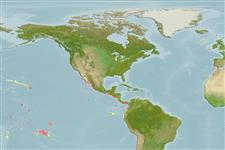>
Anguilliformes (Eels and morays) >
Chlopsidae (False morays)
Etymology: Chlopsis: Greek, chloea = green + Greek, opsis = appearance (Ref. 45335); kazuko: Named in honor of Kazuko Nakamura in recognition of her faithful and dedicated service to the LACM section of fishes by single-handedly archiving the Giles W. Mead ichthyological library (Ref. 40870).
Environment: milieu / climate zone / depth range / distribution range
Ekologi
laut dasar (demersal); kisaran kedalaman 50 - 100 m (Ref. 96339). Tropical
Eastern Central Pacific: Gulf of California. Mexico southward to Costa Rica (Ref. 97056).
Size / Weight / umur
Maturity: Lm ? range ? - ? cm
Max length : 11.3 cm SL jantan/; (Ref. 40870)
deskripsi pendek
Morfologi | Morfometrik
vertebrata, bertulang belakang: 123 - 126. Head and body pigment uniformly distributed and sharply demarcated, heavily pigmented dorsally and unpigmented ventrally; dorsal fin origin over or in front of gill opening (Ref. 40870).
Life cycle and mating behavior
Kematangan | Reproduksi, perkembang biakan | Pemijahan | telur-telur | Fecundity | Larva
Lavenberg, R.J., 1988. Chlopsid eels of the eastern Pacific with a new species and descriptions of larval forms. Bull. Mar. Sci. 42(2):253-264. (Ref. 40870)
Status IUCN Red List (Ref. 130435)
ancaman kepada manusia
Harmless
penggunaan manusia
informasi lanjut
Nama-nama umumSinonim (persamaan)metabolismePemangsaEkotoksikologiReproduksi, perkembang biakanKematanganPemijahanSpawning aggregationFecunditytelur-telurpekembangan telor
Umur / SaizPertumbuhanpanjang-beratpanjang-panjangukuran frekuensiMorfometrikMorfologiLarvaDinamika larvapemulihanKelimpahanBRUVS
AcuanBudidaya airprofil budidaya airStrainGenetikaElectrophoresesDiturunkanPenyakit-penyakitPengolahanNutrientsMass conversion
mitraGambarStamps, Coins Misc.Suara-suaraCiguateraKecepatanTipe renangArea insangOtolithsOtakPenglihatan / visi
Alat, peralatan
laporan khas
muat turun XML
Sumber internet
Estimates based on models
Preferred temperature (Ref.
123201): 15.5 - 21.6, mean 19.3 °C (based on 9 cells).
Phylogenetic diversity index (Ref.
82804): PD
50 = 0.5002 [Uniqueness, from 0.5 = low to 2.0 = high].
Bayesian length-weight: a=0.00102 (0.00046 - 0.00225), b=3.06 (2.88 - 3.24), in cm total length, based on all LWR estimates for this body shape (Ref.
93245).
Trophic level (Ref.
69278): 3.7 ±0.6 se; based on size and trophs of closest relatives
Fishing Vulnerability (Ref.
59153): Low vulnerability (10 of 100).
